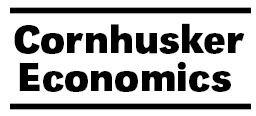Agricultural Economics, Department of

Cornhusker Economics
Date of this Version
7-30-2008
Document Type
Newsletter Issue
Citation
Cornhusker Economics
Abstract
With concerns about increasing costs on the minds of wheat farmers, it is time to look back at the past ten years to evaluate wheat production profitability. To maintain consistency over the past ten years, two systems (pivot irrigated and clean till dryland wheat fallow) were compared across the past four University of Nebraska Crop Budgets (1999, 2001, 2004 and 2006), and a 2008 update completed for Nebraska Panhandle crops.
For the irrigated production, a yield goal of 80 bushels per acre is used to determine the cost structure and to compute the potential returns for each year. The dryland yield is 40 bushels per planted acre in the traditional wheat fallow system. Although average yields in Nebraska vary by year, many producers use a yield goal for planning such inputs as seed, fertilizer and harvest costs. If the crop varies significantly from those yield goals, the producer will adjust during the season, but has to begin with some expectation of cost moving into the season. This is even more challenging for winter wheat producers who plant the crop in the fall with harvest expected in the mid-summer of the next year.
Over the past ten years there have been only a few years where the wheat producer has been able to find prices high enough to assure a profit above total costs. The wheat price has remained below $3.50 per bushel for most of the past decade. Since 2006, the price of wheat, along with most other commodities, has moved to historically high levels. The market year average price of wheat in Nebraska has increased from $2.20 per bushel in 1999 to $4.57 per bushel in 2006, with a United States Department of Agriculture (USDA) projected price for the 2008 crop of $6.25 - $8.75 per bushel ($7.50/bu is used in this example).


Comments
Published in Cornhusker Economics, 7-30-08. Produced by the Cooperative Extension, Institute of Agriculture and Natural Resources, Department of Agricultural Economics, University of Nebraska – Lincoln. http://www.agecon.unl.edu/Cornhuskereconomics.html